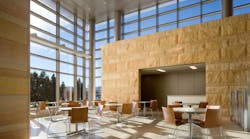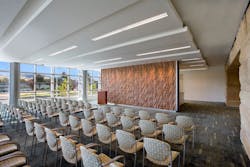It’s not unusual to feel daunted when tasked with specifying a project in the public sector.
“Designing public sector projects may feel like finding your way through a whole new landscape,” said Cheryl S. Durst, Hon. FIIDA, IIDA Executive Vice President and CEO. “Luckily, the principles and priorities of great design still apply.”
That quote sums up the first lesson in public sector specification—it’s not as different as you think.
While it’s true that procurement processes and specification requirements in the public sector can be complex, it’s important to remember that a designer’s mission remains clear: “Creating these public spaces isn’t just about meeting budgets and understanding governmental processes,” Cheryl explained, “it’s about designing with an eye to value, longevity and the ability to create places that prioritize people.”
Thus, understanding client needs is still paramount. Asking smart questions, digging into research and developing appropriate solutions are all keys to success. Letting those established best design practices guide you lays the foundation for great design in the public sector. But there are still some specific areas worth considering as you navigate the specification process.
Dig Deep on the Research
Establishing your client’s long term goals for its facilities and people is, quite simply, crucial. Today’s public sector facilities are closely aligned with the private sector in terms of workplace performance and facilities trends. Factors such as ergonomics, natural light, airflow and individual work area adjustability are areas of increasing focus.
Making sense of the client’s organizational structure is important as well. In many cases, the project team includes government professional architects, designers, leasing agents and project managers, much like private sector corporate facilities design and construction or real estate departments.
Codes and accessibility/accommodation requirements also require meticulous research. Be cognizant of prevailing codes for the client. Federal property may not always need to conform to local codes, but most government leaders are sensitive to avoiding controversy, especially around potential problem areas such as aesthetic design standards, public art, security and public access.
Lean Into Your Expertise
Often, unique factors in a public sector project can become opportunities. Historic buildings, for instance, represent a project type in which the designer provides unique value, so don’t forget to highlight your qualifications in the RFP. Agencies take great pride in their public mission, so the brand of that organization needs to be reflected in the design.
Though it is important to specify as much as possible within a manufacturer’s GSA or state/local government contract, exceptions can be made for appropriate design considerations. Don’t sell creative ideas short—instead, offer them early in the process to get client buy-in.
[Related: How to Specify for the Retail Market]
Since most public sector clients will not refresh their facilities as frequently, a designer’s expertise pays off when it comes to creating spaces with longevity. Demonstrating a focus on the overall value and long-term performance of the space reinforces the important role and contribution of the designer.
Federal and most state/local governments require that experience and past performance are the main consideration for a design contract rather than initial cost of services.
Understand the Evaluation Process
Major projects focus on three main areas of evaluation:
- Technical—This is usually a “scored” evaluation. Do the product solutions meet or exceed the specified performance criteria?
- Performance and Reliability—Can the responding party deliver the outcomes this client is expecting? If so, examples and references should be provided. Also consider the durability and quality of what is being proposed. How will it hold up over time?
- Total Cost of Ownership—The total cost of ownership goes beyond initial project cost. Consider the length of the manufacturer’s warranty and what is covered if replacement product is needed. This is important when the client is seeking long term solutions with BVD (best value determination) evaluation criteria.
Focus on Sustainability
Sustainability, a concern for designers for decades, is increasingly important. In the public sector, where sustainable practices will face public accountability, requirements may well exceed LEED and WELL standards, especially for any agency associated with the environment.
Specifying for sustainability adds significant value for the client because it can address the FAR 23.405 requirement to purchase products with recovered materials, GSA and EPA recommendations for sustainability certifications, can contribute to LEED points and allows the contractor officer to evaluate manufacturers with comparable salient features. GSA (non-Department of Defense buildings) has increased its minimum requirement for new construction and substantial renovation of federally owned facilities to LEED Gold.
When evaluating products, it’s important to remember to check alignment between manufacturers on factors such as warranty and sustainability certifications, to make an accurate comparison. Fortunately, there are several tools and resources available to help designers navigate the sustainability landscape, including:
- The Green Procurement Compilation (GPC) is a comprehensive green purchasing resource that consolidates and organizes information from federal environmental programs in one place.
- GSA’s new Fitwel standards for individual workspaces, with abundant online resources
- EPA Comprehensive Procurement Guidelines for Products
- GSA’s Green Products Sustainable Facilities Tool to help federal procurement agents identify products, their environmental attributes, and where to buy them.
Read next: Top 4 Considerations When Specifying Coated Fabrics for Upholstered Seating





